In-ceiling speakers – 7 things to know for choosing them, installing them, and creating a home with perfect sound
In-ceiling speakers are the design enthusiast's friend, giving you great sound without getting in the way of you decor

The appeal of in-ceiling speakers is an obvious one to anyone who’s looking for a house full of music without the clutter. Maybe you want to enjoy the radio in the kitchen, but need to maximize every inch of worktop space or a fully-featured surround sound system without bulky speakers in the living room? Or possibly a mixture of both, with music piped seamlessly throughout your home like a luxury hotel suite.
The joys of the best surround sound systems now are that they can be entirely hidden from view. Integrated into your home in a way that means you never have to think about them, other than just turning them on and wondering what tunes to play. However, you enjoy music, there’s a ceiling or wall-mounted speaker to suit. Here’s how to get started.
In-ceiling speakers – everything you need to know
1. Pick the right type of in-ceiling speaker for you

Traditional in-ceiling speakers like Bose consist of a speaker with flush fitting grille and ports for mains power and speaker cables. These typically need professional installation, with holes being cut and cables routed through the ceiling to wall plates, which then offer connections to traditional Hi-Fi amplifiers.
Alternatively, Kef, as well as a wide range of surround sound and stereo in-ceiling speakers, has the Ci50R, a £50 mini speaker that fits into the same space as a standard halogen light fixture, great for background music.
The speakers mentioned above still require a hi-fi or amplifier to play music, but alternatives are available including a range of one-room kits from Systemline that include speakers and a DAB radio/Bluetooth control panel.
But thankfully, the popularity of wireless music streaming means hiding speakers doesn’t always mean running miles of cables. Zuma for instance has invented a smart controlled LED spotlight and speaker in one easy to install unit, while Lithe Audio has a comprehensive range of Wi-Fi or Bluetooth streaming speakers for use with Spotify, Deezer, Amazon Music, etc. and can even be voice-controlled using Alexa or Google Assistant - the popularity of the best smart speakers means there are a lot which can be controlled from your phone.
2. Integrate before you decorate

f you want to enjoy a truly invisible hi-fi at home, you’ll need to integrate it into part of a renovation. Because unlike the best soundbars, which are easy to add in any time, nobody wants to be tracing cables into freshly dried plaster.
It is recommended that you talk to a custom installation expert like Cornflake - who is also registered with CEDIA (Custom Electronics Design and Installation Association). Working alongside your electrician, project managers, and interior designer they can hide speakers in the walls, and ceilings, disguise hi-fi cabinets, and allow you to stream from any music source from a tablet or smartphone.
These custom installation specialists are also experts in home cinemas, smart lighting, types of heating, and the latest security systems, all of which can be controlled from a single device.
3. Install in-ceiling speakers with care

If you’re handy with a toolbox, and are comfortable wiring up electrical devices, and have already mastered things like soundbar mounting ideas, you will be able to install many available in-ceiling speakers.
But do remember, aside from wiring and cutting holes in the ceiling, there’s a good chance you’ll need to trace cables into the walls, add spurs to existing lighting circuits, position the speakers in the optimal locations for the best sound quality, and checking you’ve got enough depth between the ceiling and the floor above.
Oh, and you may also need to install fire hoods for each speaker to meet Building Regulations.
4. Get the right number of speakers
Typically, ceiling speakers like Sonos Sonace come in pairs so you can enjoy true stereo sound. As a rough guide, for rooms larger than 3m2 use one pair of ceiling speakers, and for rooms bigger than 5m2 two pairs of ceiling speakers will offer a more balanced sound. Some speakers like Zuma however, are designed to bathe a room in sound, and in a small space, just one unit might be ideal.
Music streaming over Wi-Fi has also made it easier to create a multi-room music system, with the ability to play in various rooms, wake up to your favorite radio station, or turn the whole house into a nightclub, without a traditional speaker in sight.
If you want surround sound for movie nights, you will need several more speakers with between five and seven surround speakers including one of the best subwoofers for bass mounted into the wall (and ceiling if you want the latest immersive experience from Dolby Atmos).
5. Enhance their invisibility

Most in-ceiling speakers come with a low-profile, flush-fitting grille that blends into the decor. Many, including the Sonos Sonace collection, can be painted to match your living room ideas and color scheme, while Amina has redesigned the way their speaker works and can be plastered over and painted, for a truly invisible, but still great-sounding solution.
6. Place the speakers in the right rooms

Most leading brands offer humidity and moisture resistant options, meaning you can use in-built speakers in bathrooms and as part of any kitchen idea.
But be sure to look for speakers with at least an IP44 rating and they will be impervious to splashes, while IP68 is fully waterproof.
7. Budget correctly for in-ceiling speakers
Not including installation, you can add music to a single room extension for as little as $200/£150, while a whole home full of ceiling speakers costs more than $6000/£5000.
Individual in-ceiling speakers typically cost from $75/£50. These are ‘passive’ so will also need a separate amplifier or music streamer to work. Active ‘streaming’ speakers are typically more expensive, with Bluetooth options costing from $300/£220.
A single £50 speaker may be OK for a tiny space, but to get the best sound you need them carefully dotted throughout your home. Most brands mentioned here offer multi-speaker bundles, including some with amplifiers, for added convenience.
You can find exceptionally cheap retrofit speakers on Amazon, but in our experience, they won’t sound good and should be avoided. As with most audio products, it is worth sticking to established brands for the best possible quality.
As for the cost of a custom installer or electrician, this depends entirely on the scale of the project. According to Checkatrade the cost per job for an electrician ranges from $300/£250 but remember to factor in plasterers and decorators to repair any damage.
How far apart should ceiling speakers be?
Speakers should be installed at least 18 inches away from the wall, and as far apart as you'd have speakers on a conventional sound system. As a rule of thumb, they should be no closer than two meters to each other.
For rooms larger than 3m2, use one pair of ceiling speakers, and for rooms bigger than 5m2 two pairs of ceiling speakers will offer a more balanced sound.
Are ceiling speakers good for music?
Yes, ceiling speakers are great for music. They have the ability to create a surround sound feeling that envelops you, in the same way as being at a concert hall or live music event might.
In-ceiling speakers are also great to include as part of a living room TV idea if you want the same effect as going to the cinema but at home.
Be The First To Know
The Livingetc newsletters are your inside source for what’s shaping interiors now - and what’s next. Discover trend forecasts, smart style ideas, and curated shopping inspiration that brings design to life. Subscribe today and stay ahead of the curve.
Chris Haslam is a UK-based journalist who specialises in writing about tech, gadgets, audio, lifestyle and eco living. He regularly writes for Livingetc, and also contributes to WIRED, T3, Stuff, Ideal Home, House Beautiful, Your Home, Homes & Gardens, Grand Designs, Real Homes, Good Homes, Beautiful Kitchens, Country Homes & Interiors, Tesco Magazine, Style at Home and British Airways High Life Shopping
-
 Turns Out the Coolest New Café is Actually In Your Kitchen — Here's How to Steal the Style of TikTok's Latest Trend
Turns Out the Coolest New Café is Actually In Your Kitchen — Here's How to Steal the Style of TikTok's Latest TrendGoodbye, over-priced lattes. Hello, home-brewed coffee with friends. TikTok's 'Home Cafe' trend brings stylish cafe culture into the comfort of your own home
By Devin Toolen Published
-
 5 Bathroom Layouts That Look Dated in 2025 — Plus the Alternatives Designers Use Instead for a More Contemporary Space
5 Bathroom Layouts That Look Dated in 2025 — Plus the Alternatives Designers Use Instead for a More Contemporary SpaceFor a bathroom that feels in line with the times, avoid these layouts and be more intentional with the placement and positioning of your features and fixtures
By Lilith Hudson Published